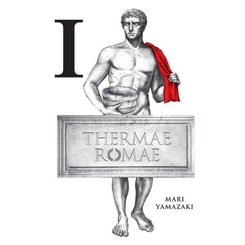Review
by Rebecca Silverman,Thermae Romae
GN 1
| Synopsis: |  |
||
Lucius Modestus is a bathing engineer in Hadrian's Rome. Out of work because of his old-fashioned sensibility, he finds inspiration and solace when a time warp unexpectedly lands him in modern day Japan. Amazed by the bathing innovations of the “flat faces,” Lucius begins designing newer and ever more popular bathhouses back in Rome, even catching the eye of the Emperor himself. But how will all of this affect his family life? And can his Roman pride accept that another culture might somehow be superior? |
|||
| Review: | |||
If manga got divided into more subcategories, Mari Yamazaki's Thermae Romae would belong in “Manga Your Father Might Actually Read.” Rich with period detail in both the art and the story, this unlikely tale of public bathing manages to be fascinating and engrossing even to an audience to whom the idea of getting naked in a tub with perfect strangers sounds more gross than appealing. It has its problems to be sure, but overall Thermae Romae is worth a second look. Part of that is because Yen Press has really put their all into the production of this first volume. A hardcover the size of the average bestseller, it features a clear dust jacket (with the title conveniently covering the manly bits of the cover image) and glossy pages such as you would find in an American comic. The oversize pages allow for a clearer grasp of the the detail Yamazaki has put into the drawings of Ancient Rome, from the individual paving stones in the street to the graffiti on the walls. Notes on both Latin and Japanese words and concepts are provided in the back and the lack of advertising after the story gives the entire book a more polished, serious feel. At $35, it is pricey, but it is clear that this volume is intended for the connoisseur rather than the casual manga reader. Likewise those who tend to separate their manga shelves from their prose ones may want to consider shelving this with the “regular” books, as this is a beautiful volume. The story itself is fairly basic and suffers some from a repetitive formula established in the first chapter. Lucius Modestus (there is a distinct lack of nomen amongst the characters, which is a little odd) sees or is presented with an issue regarding one of Rome's bathhouses. While pondering it, he slips in the tub, resulting in him rising not-so-majestically to the surface of a Japanese bath, where he observes an answer to his problem. He then mysteriously returns to Rome, where people tell him he passed out, and proceeds to build an imitation of what he saw. It is wildly popular and he feels mildly ashamed that he did not come up with it himself, like a good Roman should. While the plot shows some small differences in what the problems are or who asks him to solve them, for the most part the book is distinctly formulaic. It is saved from being totally repetitious by the small details of Lucius' personal life and that of his friend Marcus the sculptor, and the first chapter of what would have been volume two (chapter 6) does take a slightly different tone in that it is about Lucius' erectile issues. As might be imagined in a story about bathing, there is a lot of nudity in this story, although very few actual penises. The aforementioned chapter six, which is about phallic worship in both Ancient Rome and Japan, has the most, but overall this is fairly unobjectionable nudity. Yamazaku draws an impressive array of male figures, deftly showing differences in race, age, and occupation through their body types and even paying attention to which cultures disliked body hair. All in all the art is really quite something, with the Romans looking rather like statues, especially Hadrian, and the Japanese taking on a more cartoony, manga-styled appearance. As has been mentioned, historical backgrounds are remarkable, really giving a sense that we could just slip through the page and be on a Roman street. In-between each chapter is a short essay by Yamazaki about her research and thoughts on bathing. These at times come off as a little “rah rah Japan,” as she clearly doesn't think much of European bathing practices (she doesn't mention America), but the photographs she supplies and some of the anecdotes are fascinating. These essays are easily skipped if you don't care for her tone, however, and will not affect your enjoyment of the stories. Thermae Romae is far more interesting than a formulaic story about public bathing ought to be. Fascinating in its cultural and historical detail, not to mention its parallels between disparate cultures, beautifully put together, and giving a very firm sense of place, this is a story that should get your attention. It isn't perfect, but it is interesting in the best of ways, and if nothing else, it will make you want to go fill up the tub for a nice long soak. |
| Grade: | |||
|
Overall : B+
Story : B
Art : A-
+ Detailed, rich art, interesting cultural parallels and historical detail. Great presentation. |
|||
| discuss this in the forum (22 posts) | | |||
| Production Info: | ||
|
Full encyclopedia details about Release information about |
||